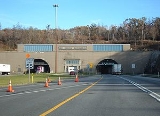
Allegheny Mountain Tunnel
Encyclopedia
The Allegheny Mountain Tunnel is a vehicular tunnel
carrying the Pennsylvania Turnpike
through the Allegheny Mountains
. At this point, the Turnpike carries Interstates 70
and 76
. The original Allegheny Mountain Tunnel was built in the late 19th century for the South Pennsylvania Railroad
, which was never completed. This tunnel was not used due to concerns about its structural integrity.
The eastern end of this original tunnel can be seen by parking on the service road at the turnpike's eastern portal and walking up to the area just above and a bit north of the turnpike portal. The opening is visible in the rocks just uphill. Entering this old tunnel is prohibited.
The current westbound tunnel was built in 1939 as part of the original construction for the highway. At first, this tunnel served both westbound and eastbound traffic with a single lane in each direction. The eastbound tunnel was completed in 1965 as part of an expansion and upgrade of the turnpike due to increased traffic volume. Both tunnels are approximately 6,070 feet (1,850 m) in length. Explosives and other hazardous materials are not allowed in the tunnels. Vehicles carrying these materials must exit before the tunnel and take other roads around the tunnel. Restrictions on some hazardous materials in non-bulk form have been lifted.
Long term plans call for major maintenance to be performed on the tunnels; however, this presents a major problem for traffic. Terrible backups prompted officials to build the second tube. With today's traffic volumes, it would not be feasible to close one tube and route all traffic through the other. Possible plans include building a third tunnel, as well as bypassing the tunnels completely as was done for the Rays Hill
and Sideling Hill Tunnel
s.
Tunnel
A tunnel is an underground passageway, completely enclosed except for openings for egress, commonly at each end.A tunnel may be for foot or vehicular road traffic, for rail traffic, or for a canal. Some tunnels are aqueducts to supply water for consumption or for hydroelectric stations or are sewers...
carrying the Pennsylvania Turnpike
Pennsylvania Turnpike
The Pennsylvania Turnpike is a toll highway system operated by the Pennsylvania Turnpike Commission in the Commonwealth of Pennsylvania, United States. The three sections of the turnpike system total . The main section extends from Ohio to New Jersey and is long...
through the Allegheny Mountains
Allegheny Mountains
The Allegheny Mountain Range , also spelled Alleghany, Allegany and, informally, the Alleghenies, is part of the vast Appalachian Mountain Range of the eastern United States and Canada...
. At this point, the Turnpike carries Interstates 70
Interstate 70
Interstate 70 is an Interstate Highway in the United States that runs from Interstate 15 near Cove Fort, Utah, to a Park and Ride near Baltimore, Maryland. It was the first Interstate Highway project in the United States. I-70 approximately traces the path of U.S. Route 40 east of the Rocky...
and 76
Interstate 76 (east)
Interstate 76 is an Interstate Highway in the United States, running 435 miles from an interchange with Interstate 71 west of Akron, Ohio, east to Interstate 295 near Camden, New Jersey....
. The original Allegheny Mountain Tunnel was built in the late 19th century for the South Pennsylvania Railroad
South Pennsylvania Railroad
The South Pennsylvania Railroad is the name given to two proposed but never completed Pennsylvania railroads in the nineteenth-century. Parts of the right of way for the second South Pennsylvania Railroad were reused for the Pennsylvania Turnpike....
, which was never completed. This tunnel was not used due to concerns about its structural integrity.
The eastern end of this original tunnel can be seen by parking on the service road at the turnpike's eastern portal and walking up to the area just above and a bit north of the turnpike portal. The opening is visible in the rocks just uphill. Entering this old tunnel is prohibited.
The current westbound tunnel was built in 1939 as part of the original construction for the highway. At first, this tunnel served both westbound and eastbound traffic with a single lane in each direction. The eastbound tunnel was completed in 1965 as part of an expansion and upgrade of the turnpike due to increased traffic volume. Both tunnels are approximately 6,070 feet (1,850 m) in length. Explosives and other hazardous materials are not allowed in the tunnels. Vehicles carrying these materials must exit before the tunnel and take other roads around the tunnel. Restrictions on some hazardous materials in non-bulk form have been lifted.
Long term plans call for major maintenance to be performed on the tunnels; however, this presents a major problem for traffic. Terrible backups prompted officials to build the second tube. With today's traffic volumes, it would not be feasible to close one tube and route all traffic through the other. Possible plans include building a third tunnel, as well as bypassing the tunnels completely as was done for the Rays Hill
Rays Hill Tunnel
Rays Hill Tunnel is one of three original Pennsylvania Turnpike tunnels which were abandoned after two massive realignment projects. The others included the Sideling Hill Tunnel, and further west, the Laurel Hill Tunnel. The reason for abandonment was because it was thought to be less expensive...
and Sideling Hill Tunnel
Sideling Hill Tunnel
Sideling Hill Tunnel is one of three original Pennsylvania Turnpike tunnels abandoned after two massive realignment projects. The others are nearby Rays Hill Tunnel, and further west, the Laurel Hill Tunnel. It was less expensive to realign the Turnpike than to bore a second tube for four lane...
s.

